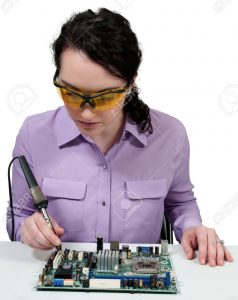Seville Road State School and OpenSTEM got coverage on Channel TEN News yesterday afternoon with the Robotics Program, in their “TEN at Schools” segment. Good exposure for a great school.




Seville Road State School and OpenSTEM got coverage on Channel TEN News yesterday afternoon with the Robotics Program, in their “TEN at Schools” segment. Good exposure for a great school.




Horays, our new polo shirts have arrived! We’re very happy with how they came out with the embroidered owl logo.

We go out & about quite a bit to schools and other events, so it’s useful to be easily recognisable in those environments. The shirts standardise that effort and the colour scheme matches our branding very well.
On the rack, it looks a bit like the outfits for a sports team 😉
http://esheninger.blogspot.com.au/2016/03/substance-over-assumptions-and.html
“When integrating technology there needs to be a Return on Instruction (ROI) that results in evidence of improved student learning outcomes.”
— Eric Sheninger
For educational technology to be fully embraced as a powerful teaching and learning tool there must be a focus on substance over assumptions and generalizations. There is a great deal of evidence to make educators reflect upon their use of technology. The most glaring was the OECD Report that came out last fall. Here is an excerpt:
“Schools have yet to take advantage of the potential of technology in the classroom to tackle the digital divide and give every student the skills they need in today’s connected world, according to the first OECD PISA assessment of digital skills.
Even countries which have invested heavily in information and communication technologies (ICT) for education have seen no noticeable improvement in their performances in PISA results for reading, mathematics, or science.”
Read the full article on Eric Sheninger’s blog site.
 This T-shirt sums up soldering basics quite well. Funny too. But I hear you say, surely you don’t need to really explain that?
This T-shirt sums up soldering basics quite well. Funny too. But I hear you say, surely you don’t need to really explain that?
I’d agree, and in our experience with soldering with primary school students in classrooms, we’ve never had any such fuss.
However, in stock photography, we find the following “examples”…
 This stock photo model (they appear in many other photos) is holding a hot air gun of a soldering rework station, by the metal part! If the station were turned on, there’d be third degree burns and a distinct nasty smell…
This stock photo model (they appear in many other photos) is holding a hot air gun of a soldering rework station, by the metal part! If the station were turned on, there’d be third degree burns and a distinct nasty smell…
The open hard disk assembly near the front is also quite shiny…..
As if one isn’t enough, here’s another stock photo sample, again held by the metal part:
 On a practical level, it’s very unlikely you’d be dealing with a modern computer main board using a regular soldering iron, on the component side.
On a practical level, it’s very unlikely you’d be dealing with a modern computer main board using a regular soldering iron, on the component side.
But what actually annoyed me most about this photo is something else: the original title goes something like “beautiful woman … soldering …”. Relevance? The other photo doesn’t say “hot spunk soldering”, and although that would be just as irrelevant, fact is that with articles and photos of professional women, their appearance is more often than not made a key part of their description. Which is just sexist garbage, bad journalism and bad copy-writing.

Which brings us to this final soldering stock photo sample. Just What The?
Female body selling soldering iron? Come on now. “Bad taste” doesn’t even remotely sum up the wrongness of it all.
Note: the low-res stock photo samples in this article are shown in a satirical fair-use context.
Did you know that the pi symbol (π) was only introduced in 1706, William Jones (1675-1749) used it in his Synopsis palmariorum matheseos, most likely after the initial letter of the Ancient Greek περιφέρεια (periphéreia), meaning periphery (the line around the circle).
Before then, instead of π, the long Latin phrase “quantitas, in quam cum multiplicetur diameter, provenient circumferentia” had been used, meaning “the quantity which, when the diameter is multiplied by it, gives the circumference”. Clear, but quite a mouthful! In any case they had worked out that there was a mathematical constant there, which I reckon is already pretty cool.
Anyhow, π approximations! So who got close, and when? The answer may surprise you.
Archimedes got to that value by applying his method for calculation of arc length to determine π. Beginning with regular hexagons – inscribed in, and circumscribed to a circle – and doubling the number of sides four times until he had a pair of regular 96-gons, he calculated the length of the perimeters of the successive polygons.
After that, no essentially new ideas for the calculation of π were suggested until the development of calculus towards the end of the 17th century! Of course, this had everything to do with the fall of the West Roman Empire in 476, which triggered the “Dark Ages” in Europe for a 1000 years. Mathematics and other sciences progressed very slowly in Europe during that time. But outside of Europe, things were actually moving along.
In India:
unfortunately neither bothered telling how they got to those figures.
In China:
In Persia:
Back to Europe (after the end of the Dark Ages):
Ludolph van Ceulen (1540-1610), a fencing master teaching arithmetic, surveying and fortification at the engineering school at Leiden in Holland, got to 20 decimals of π in Van den Circkel (“About the Circle”, 1596), followed by 32 decimals in Arithmetische en Geometische fondamenten (“Arithmetic and Geometric fundamentals”), published posthumously in 161, and 35 decimals published in 1621 by his pupil Willebrord Snel,
π = 3.141 592 653 589 793 238 462 643 383 279 502 88
the last three digits of that were engraved as an epitaph on van Ceulen’s tombstone! Van Ceulen’s accomplishment so impressed his contemporaries that π was often called the Ludolphine constant.
In conclusion… van Ceulen’s later accomplishments notwithstanding, it’s important to recognise the very significant achievements of the early Chinese and Persians over a thousand years earlier! (I’d include the Indians but they really should have shown their working)
Many awesome facts sourced from: Mathematics, from the Birth of Numbers (Jan Gulberg).

Ray Tomlinson (Amsterdam, New York state USA, 23 April 1941 – 5 March 2016) invented email in 1971. While working at a company in Massachusetts that had computers on the ARPANET (which morphed into the Internet we know), he thought it would be a good idea if employees were able to send messages to each other as well as files. He choose the ‘@’ sign separate the username from the machine (host) name which he added, enabling the system to distinguish a remote username from a local one.
Email wasn’t actually part of the actual project he was supposed to be working on… but it caught on very quickly because of its obvious benefits. Fast forward to now.. in 2015 it was estimated more than 200 billion emails are sent daily, but that number does include spam which actually makes up a large proportion (about half in 2015).
It is also estimated there are currently over 4 billion email addresses – unfortunately that doesn’t quite mean that more than half the planet’s population has email, as quite a few people have more than one email address, and also computer programs can have an email address of their own.
Tomlinson was co-author on an early standards document RFC-561: Standardizing Network Mail Headers (5 Sep 1973), which was one of the predecessors of the current email standard RFC-822: Standard for the format of ARPA Internet Text Messages (13 Aug 1982).
I played this game 3 or 4 times with my grade 4 son. He said he would enjoy it more…
Brad